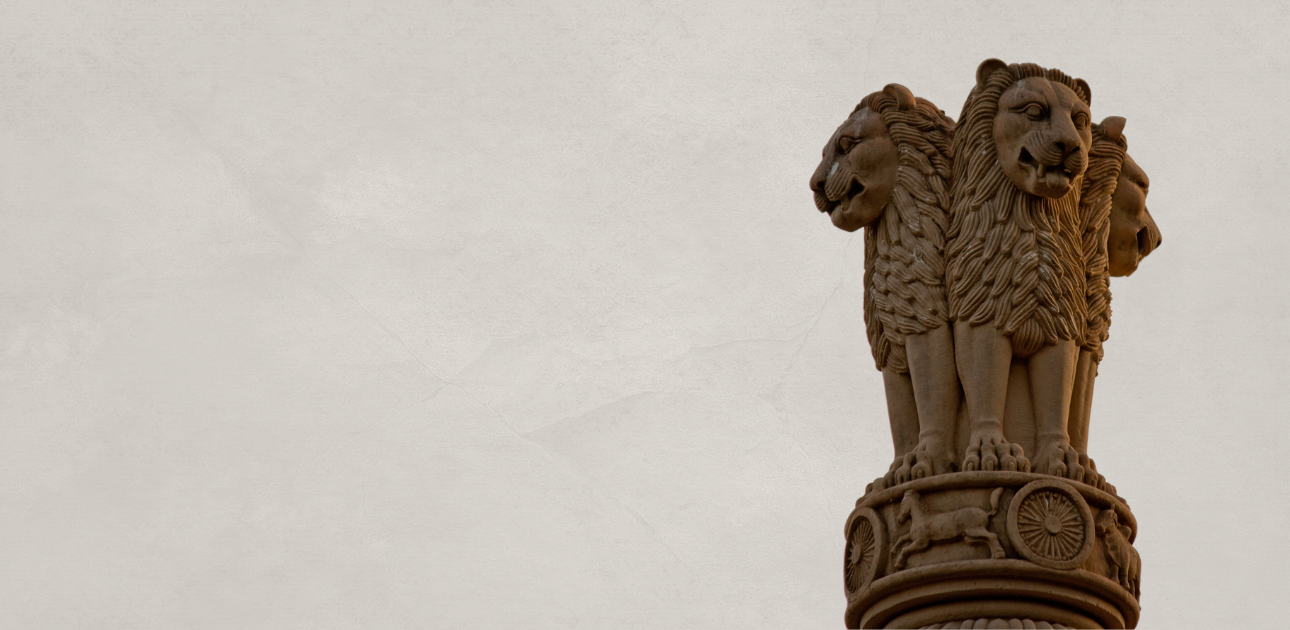The government should either replace the distorted replica with the genuine one at Sarnath, or publish a notification in the Official Gazette of India to justify its decision.
——
ON July 11, Prime Minister Narendra Modi unveiled what was purportedly “the national emblem”, installed on the roof of the new Parliament building in New Delhi. It needs to be emphasized that the Prime Minister himself has asserted that what he had unveiled was the national emblem, as a press release from the Press Information Bureau confirmed.
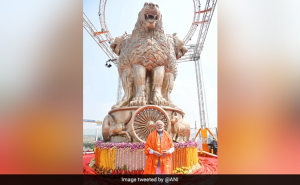

However, after images of the replica were shared on social media, as a PTI report has noted, “the opposition parties have taken objections, accusing the Centre of replacing the ‘graceful and regally confident’ Ashokan lions with those having menacing and aggressive posture.”
The so-called “national emblem” which has been installed on top of the new Parliament building, does appear to be an un-aesthetic and almost crude replica that neither conforms to its original design nor matches perfectly with the design as specified in Appendix II of the State Emblem of India (Prohibition of Improper Use) Act, 2005.
Several leaders of the Opposition and prominent individuals have accused the Union Government of “distorting” the national emblem. Indian National Congress leader and Rajya Sabha Member of Parliament (‘MP’) Jairam Ramesh, in a tweet, said: “To completely change the character and nature of the lions on Ashoka’s pillar at Sarnath is nothing but a brazen insult to India’s National Symbol!”
Similar views were tweeted by Jawhar Sircar, retired Indian Administrative Services officer and currently a Rajya Sabha MP with the All India Trinamool Congress.
Insult to our national symbol, the majestic Ashokan Lions. Original is on the left, graceful, regally confident. The one on the right is Modi’s version, put above new Parliament building — snarling, unnecessarily aggressive and disproportionate. Shame! Change it immediately! pic.twitter.com/luXnLVByvP
— Jawhar Sircar (@jawharsircar) July 12, 2022
Public interest lawyer Prashant Bhushan too has expressed his outrage on Twitter in this regard.
From Gandhi to Godse; From our national emblem with lions sitting majestically & peacefully; to the new national emblem unveiled for the top of the new Parliament building under construction at Central Vista; Angry lions with bared fangs.
This is Modi's new India! pic.twitter.com/cWAduxPlWR— Prashant Bhushan (@pbhushan1) July 12, 2022
Counter claim
In a bid to counter such criticisms, Union Minister for Housing and Urban Affairs, Hardeep Singh Puri, on July 12 tried to defend the government’s depiction of the national emblem cast atop the new Parliament building. According to Hindustan Times,“[i]n a series of tweets, the housing and urban affairs minister asserted that there would not be any difference between the original Sarnath emblem and the one installed on the new Parliament building if the former is scaled up or the latter is reduced to the original size.”
In one of his re-tweets, Puri appears to be concurring with the claims by Jawaharlal Nehru University faculty Heeraman Tiwari that: (a)“This #NationalEmblem on top of our #NewParliamentBuilding is a perfect replica of the original Lion’s Capital of Aśoka at Sāranātha [sic], except that its size is 3 times of the original in Sarnath.”; and (b) “…that this emblem fully conforms to its original design.”
This #NationalEmblem on top of our #NewParliamentBuilding is a perfect replica of the original Lion's Capital of Aśoka at Sāranātha, except that its size is 3 times of the original in Sarnath. Anyone questioning its design has to be ignorant of ancient Indian iconography&history. https://t.co/qO1ocYw7Sx
— हीरामनHeeramanतिवारीTiwari 🇮🇳 (@heeraman98) July 12, 2022
Is the purported “National Emblem” on top of the new Parliament building “a perfect replica” of the original Lion Capital of Ashoka at Sarnath, as is being claimed? Is it true that it “fully conforms to its original design”? Does it match perfectly with the design as specified in Appendix II of the State Emblem of India (Prohibition of Improper Use) Act, 2005?
The answer is no, not at all!
Stark difference
The so-called “national emblem” which has been installed on top of the new Parliament building, does appear to be an un-aesthetic and almost crude replica that neither conforms to its original design nor matches perfectly with the design as specified in Appendix II of the 2005 Act. Moreover, while the original Lion Capital of Ashoka at Sarnath is certainly a product of exquisite craftsmanship, its poor replica on top of the new Parliament building is evidently not a product of the same standard.
The government is empowered to bring about changes in the design of the National Emblem under Section 11 of the 2005 Act. But such changes can be brought about only by first publishing a notification in the Official Gazette of India as clearly stipulated in Section 11(1) of the Act.
The difference in design between the original and the present replica is stark. This becomes evident when a close-up photograph of the Lion Capital of Ashoka at Sarnath is compared with a close-up photograph of the said enlarged replica as shown below.
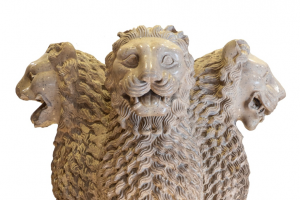

Courtesy: Kevin Standage
In the above photograph of the original Lion Capital of Ashoka at Sarnath, the upper and lower canine teeth of the lion are positioned side by side, with the upper and lower jaws almost closed. The facial expression is calm and composed.
In the photograph below of the said “perfect” replica, the upper canine teeth are positioned on top of the lower ones, and the upper and lower jaws are wide open, which is clearly an image of an angry, snarling lion.
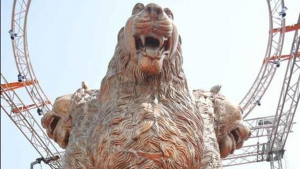

Courtesy: ANI
Other drawbacks
The said replica has other drawbacks as well, as pointed out by the right-wing monthly print magazine and news portal Swarajya. In an article titled “India’s State Emblem Has Fangs”, economist and writer, Sanjeev Sanyal, while aggressively defending the government, could not but admit to the following:
“…no one seems to have commented in [sic] two significant ways in which the replicas do deviate from the original. First, the new lions seem better fed than the Mauryan lions. Second, they have eyes inserted into the empty sockets of the originals. This may give the impression of being more aggressive at some angles…”
Therefore, contrary to the claims being made by Puri and other Bharatiya Janta Party leaders, the criticisms raised are absolutely valid: the replica installed on top of the new Parliament building is a distorted version of the original Lion Capital of Ashoka at Sarnath. In other words, the Union Government is guilty of improper use of the National Emblem, which is a punishable offence under Section 7(1) of the State Emblem of India (Prohibition of Improper Use) Act, 2005. (However, the government will escape any such punishment since previous sanction for such punishment has to be granted by the Union Government under Section 8 of the Act.) Nevertheless, it is amply evident that the government has transgressed the existing laws by its improper use of the national symbol.
Of course, the government is empowered to bring about changes in the design of the National Emblem under Section 11 of the Act. But such changes can be brought about only by first publishing a notification in the Official Gazette of India as clearly stipulated in Section 11(1) of the Act. As of today, the government has not published any such notification about changing the design of the National Emblem in the Official Gazette.
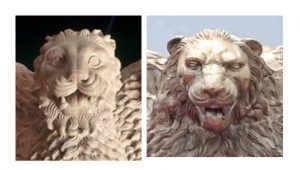


Courtesy: Ram Rehman
The knowledge that it will never be taken to task for such transgression, has impelled the government to act recklessly. Such an indifferent attitude is a poor reflection on its moral righteousness.
A conscious act
The said Swarajya comment has also let the cat out of the bag! The design changes are not just the result of poor craftsmanship; there was a deliberate attempt to portray the lions in an angry mood. According to Sanyal:
“Even a cursory look shows that the Mauryan lions show their teeth. The Mauryans were unapologetic empire builders and the lions stood at the place where ancient India’s most important highways met – the Uttarapath and the Dakshinapath. It was a proclamation of the power of the State to be carried in all directions.” (Emphasis added)
There is a world of difference between “showing their teeth” and “baring their teeth”. While the lions on the Lion Capital of Ashoka at Sarnath do show their teeth, their jaws are nearly shut and their facial expressions are by no means aggressive. On the other hand, the lions on the said replica are baring their teeth with their jaws far apart, and are decidedly displaying aggression.
Even assuming that the “most blatant distortion” is in the statute itself, corrective measures can be made only as per the procedure described in the statute, which is through a notification in the Official Gazette of India. The so-called corrective measures cannot be carried out according to the whims and fancies of the Union Government.
Sanyal then goes on to claim as follows:
“An important reason is that official depictions since the nineteen-fifties had distorted the image to make them look more benign in order to conform to the myth of a pacifist past…. Ironically, the most blatant distortion is in The State Emblem of India (Prohibition of Improper Use) Act 2005.”
Even assuming that the “most blatant distortion” is in the statute itself, corrective measures can be made only as per the procedure described in the statute, which is through a notification in the Official Gazette of India. The so-called corrective measures cannot be carried out according to the whims and fancies of the Union Government. All that the Swarajya piece by Sanyal has tried to do is to somehow attempt to defend the indefensible folly of the government, which is trying to project itself as heading an aggressive State.
That the Union Government has the entire necessary wherewithal to produce exact replicas of the Lion Capital of Ashoka at Sarnath is evident from the following photograph.
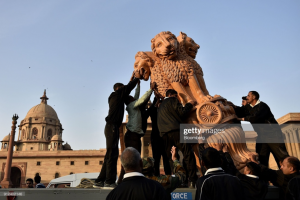

Courtesy: Getty Images
The caption says: “Workers unload a statue of the Indian national emblem Ashoka Stambha outside the North Block of the Central Secretariat buildings, which houses the Ministries of Finance and Home Affairs, in New Delhi, India, on Tuesday, Jan. 30, 2018.”
The government has to be taken to task for blatantly violating existing Rules and Regulations. The manner in which it is openly disregarding Constitutional propriety has to be questioned.
The government should either replace the distorted replica with a perfect one of the Lion Capital of Ashoka at Sarnath, or publish a notification in the Official Gazette of India to justify its decision. Laws should not be allowed to be violated with impunity.

